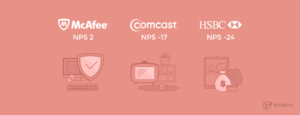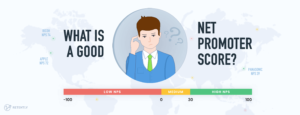The key to success for SaaS companies lies in prioritizing the positive experience of their clients through a customer-centric approach. While there are many ways to do that, measuring satisfaction levels and actively seeking relevant feedback is critical to improving customer journeys. Without a strong focus on these aspects, SaaS companies risk falling behind the competition and losing valuable customers.
When it comes to gathering customer feedback, the options are endless: comments, social media, emails, and chats with support teams. Yet, if you’re looking for a quick and reliable source of relevant information, surveys remain the go-to choice for successful businesses looking to improve customer experience.
The most widely used surveys to assess customer satisfaction levels are NPS, CSAT, and CES. While they measure customer experience at different stages in the customer lifecycle, all three equip SaaS companies with actionable insights that can help enhance the product, reduce churn and drive growth.
This article will explore how SaaS companies can efficiently incorporate satisfaction surveys into the customer journey and get relevant feedback for impactful changes. Join us as we delve into the power of CX surveys and how they can transform your SaaS business.
What is NPS, CSAT, and CES?
Before we get to the implementation itself, let’s define what exactly NPS, CSAT, and CES mean.
NPS is one of the most popular metrics and measures customer loyalty.
Naturally, the higher the score, the more satisfied customers are. The survey usually consists of a simple 0 to 10 rating question – “How likely is it that you would recommend our company/product/service to a friend or colleague?” – followed by open-ended questions allowing customers to explain the reason behind their score.
In the NPS system, clients who select a score of 9 or 10 are known as Promoters, those who choose a score of 8 or 7 are called Passives, while those who rate their experience as 0 to 6 are identified as Detractors. The NPS score is the difference in percentage between Promoters and Detractors.
Though the NPS question is simple, it gives a clear picture of where your customers stand in relation to your company. By benchmarking and monitoring the score regularly, SaaS businesses can immediately spot any shifts in attitude and take appropriate measures to tackle arising issues, thus increasing CLV. In addition, it surfaces opportunities for cross- and upselling and provides visibility into the number of customers who willingly promote your business.
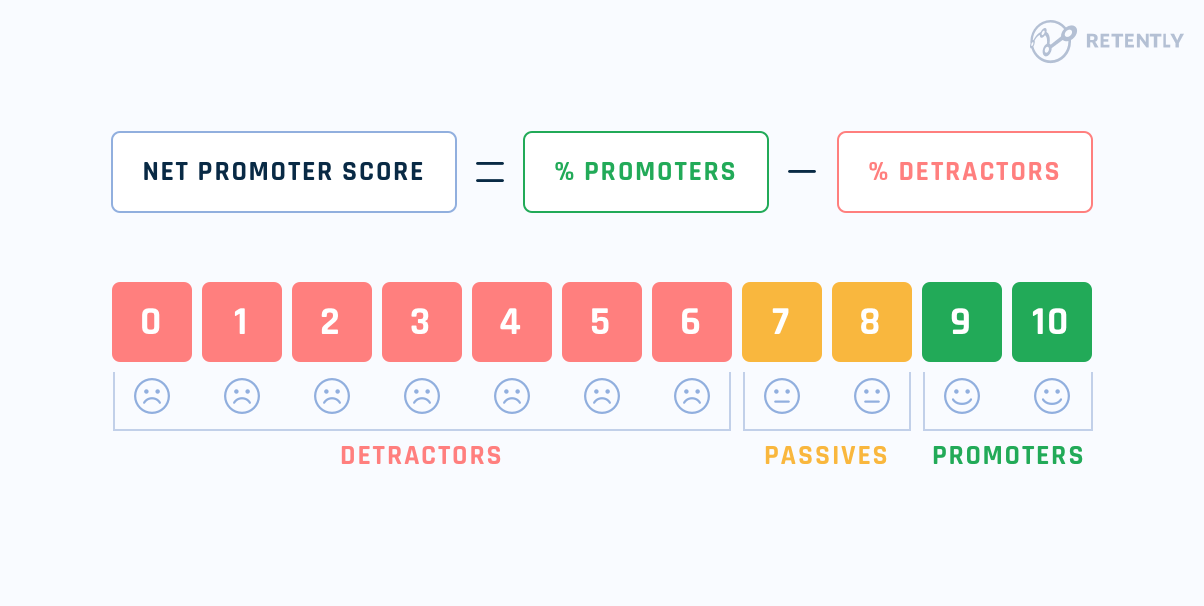
While NPS measures the overall satisfaction with your brand, CSAT surveys are more specific. CSAT stands for Customer Satisfaction Score and is sent after a customer interacts with your business to see how satisfied they are with the product or the interaction itself. The answers usually lie between the very satisfied – very dissatisfied range, but, as in the case of NPS, they don’t provide much actionable feedback unless open-ended questions follow. Here customers can expand on the reasons behind the given score while their suggestions are used to boost satisfaction and improve the product itself.
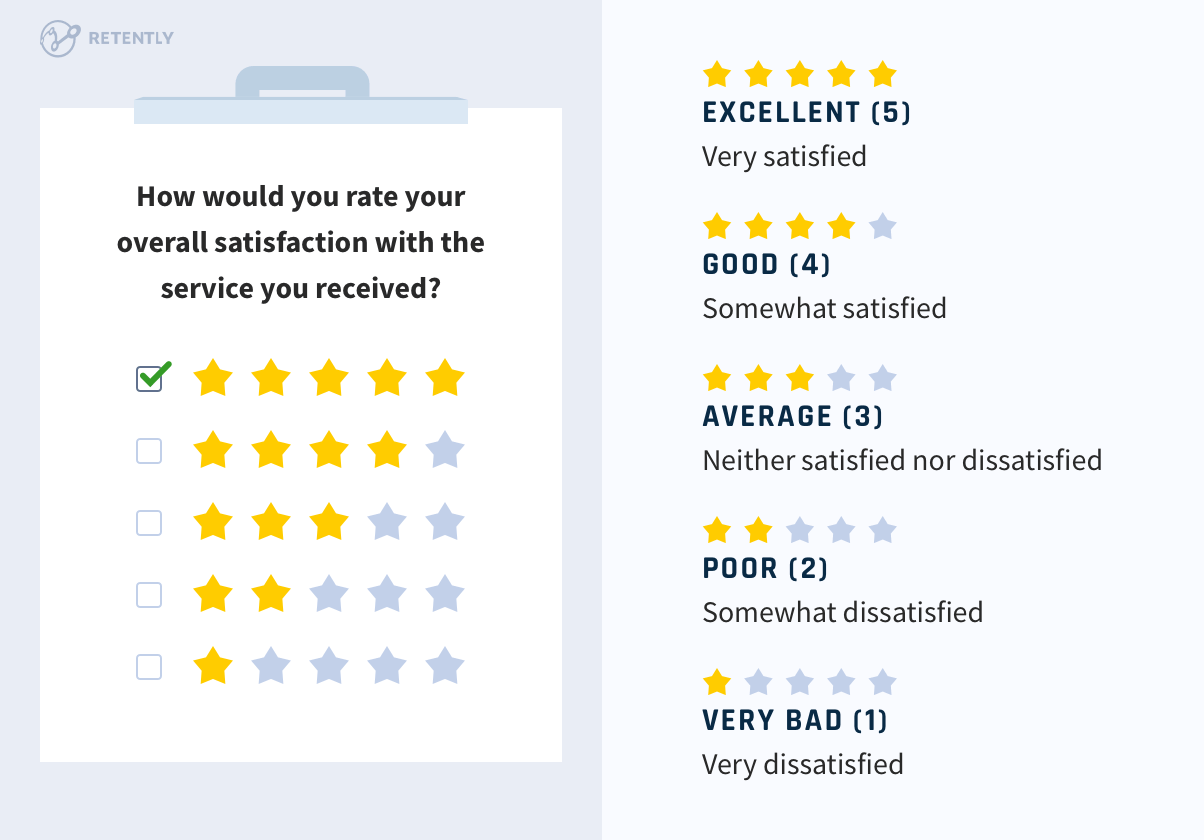
CES, which stands for Customer Effort Score, is another satisfaction metric that measures how easy or difficult it is to interact with a product or service. It proves helpful when SaaS businesses want to know how smooth the onboarding process is or whether customers have a hard time using any of their services. Again, following up with open-ended questions will give additional insights to be implemented in the development process.
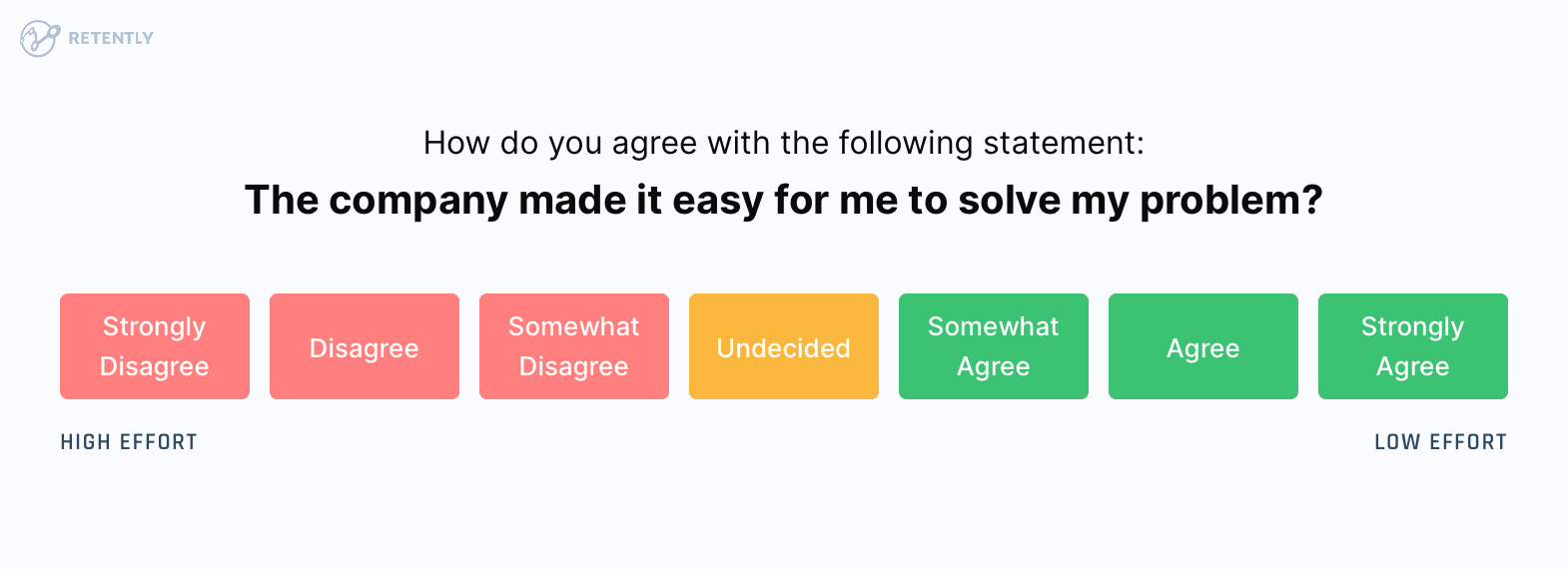
These surveys provide immediate actionable feedback every SaaS company needs to boost retention and inform their product roadmap. In addition, every department, be it customer success, product, or support teams, can leverage them by triggering survey campaigns at specific stages in the customer journey.
CX Surveys by SaaS Customer Journey Touchpoints
A seamless SaaS customer journey involves identifying the touchpoints where customers interact with the software and ensuring meaningful experiences along the way.
By targeting surveys to specific stages of the SaaS customer lifecycle and acting on the received data, teams can create a culture of customer feedback that drives continuous improvement and long-term success. Since customers are the primary asset of any SaaS business, companies need to focus on survey campaigns to enhance their overall experience.
So, let’s explore the different stages in the SaaS customer journey and the suitable surveys to use for capturing valuable customer insights.
-
Product Discovery Stage
The discovery phase represents the first encounter potential customers have with your product, whether it’s through your website, a demo, or word of mouth. To make a great first impression, you need a seamless experience with easy-to-find product information, engaging demos, and high-quality marketing materials. This initial interaction can make or break a prospect’s perception of your product and company.
At this stage, SaaS companies can identify any confusion about their product and address it via improved messaging and additional product information. This way, they can refine their communication approach and target potential clients more efficiently.
Running surveys at this stage can also provide helpful feedback for product development. Understanding what the target audience is looking for in a product allows SaaS companies to tailor their offer accordingly.
Product usability survey
The goal of these surveys is to identify any obstacles visitors may face while initially navigating the app and how it can be improved to provide a better user experience. These surveys include questions about the ease of finding information, the clarity of the messaging, the layout or design, and the overall UX/UI experience.
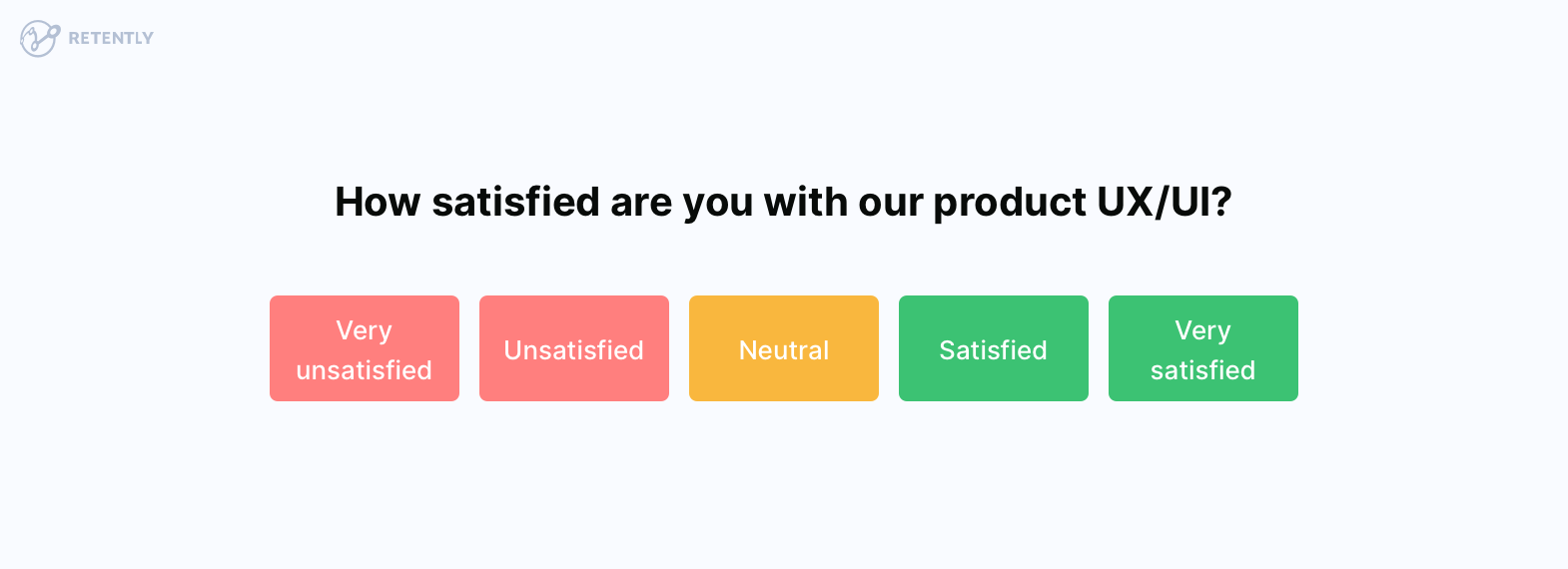
The most relevant customer satisfaction metrics at this point are CSAT and CES.
Trigger CSAT surveys to evaluate satisfaction with product materials and other resources relevant to product discovery. At the same time, you can use Customer Effort Score surveys to assess how easy it is for customers to access product information. Choose one of the two survey types that best fit your goals.
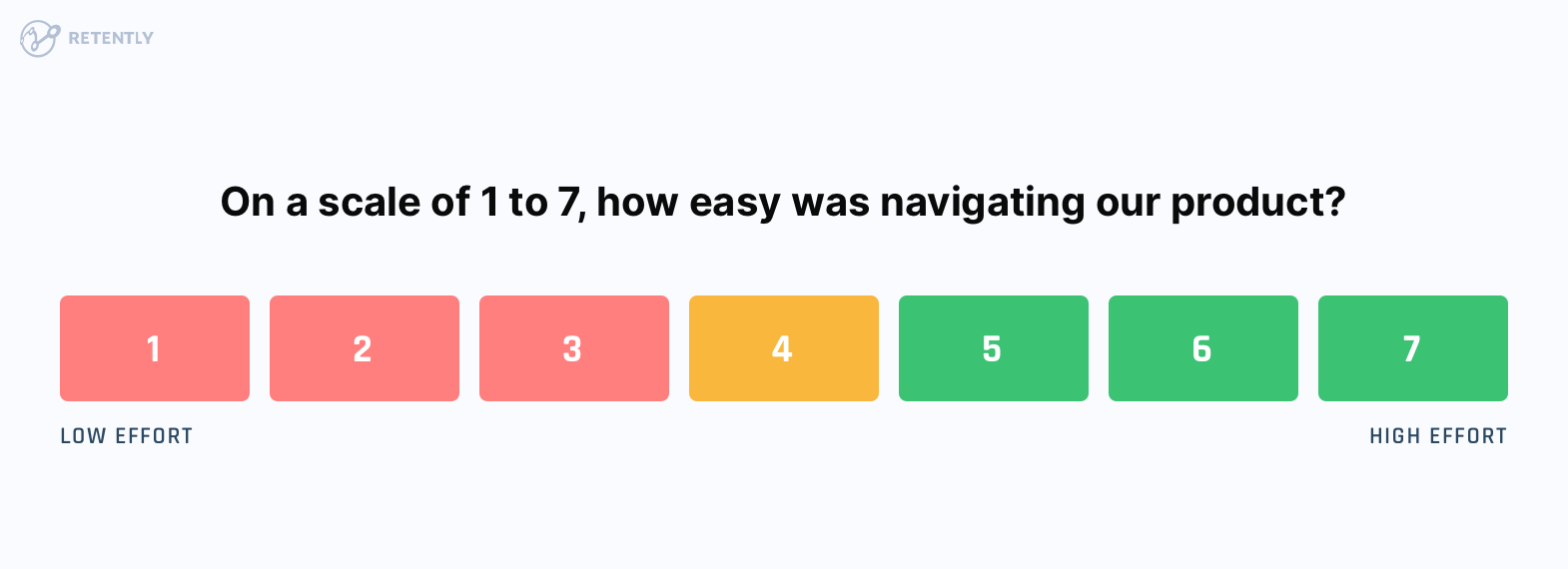
For example, you can display an in-app survey while the user is exploring or when exiting the Knowledgebase or the FAQ section to find out how helpful the scrolled-through information was. Using these customer satisfaction surveys, companies can identify any barriers to entry that may prevent customers from moving forward in the journey.
Here are some survey questions to help you get started:
- How satisfied are you with our product UX/UI?
- How satisfied are you with our product documentation?
- On a scale of 1 to 7, how easy was navigating our product?
As a bonus, below you have additional questions you can use at this stage:
- How user-friendly do you find our product/service?
- How easy was it for you to navigate our website/app?
- Were you able to find the information/features you were looking for?
- How satisfied are you with the usability of the website?
- Is there any functionality that you found difficult to understand?
- Did you encounter any technical issues or errors while using our website/app?
- How satisfied are you with the layout/design of our website?
- How would you rate the comprehensiveness of the displayed product information?
- How easy was it to find the required product information?
- What missing features from our website would have made your experience better? (open-ended question)
Post-demo survey
Sending surveys after a demo call can provide valuable insights into its effectiveness and uncover ideas for a more comprehensive experience. Leverage this feedback to optimize the process and increase the likelihood of convincing potential customers to continue with a free trial.
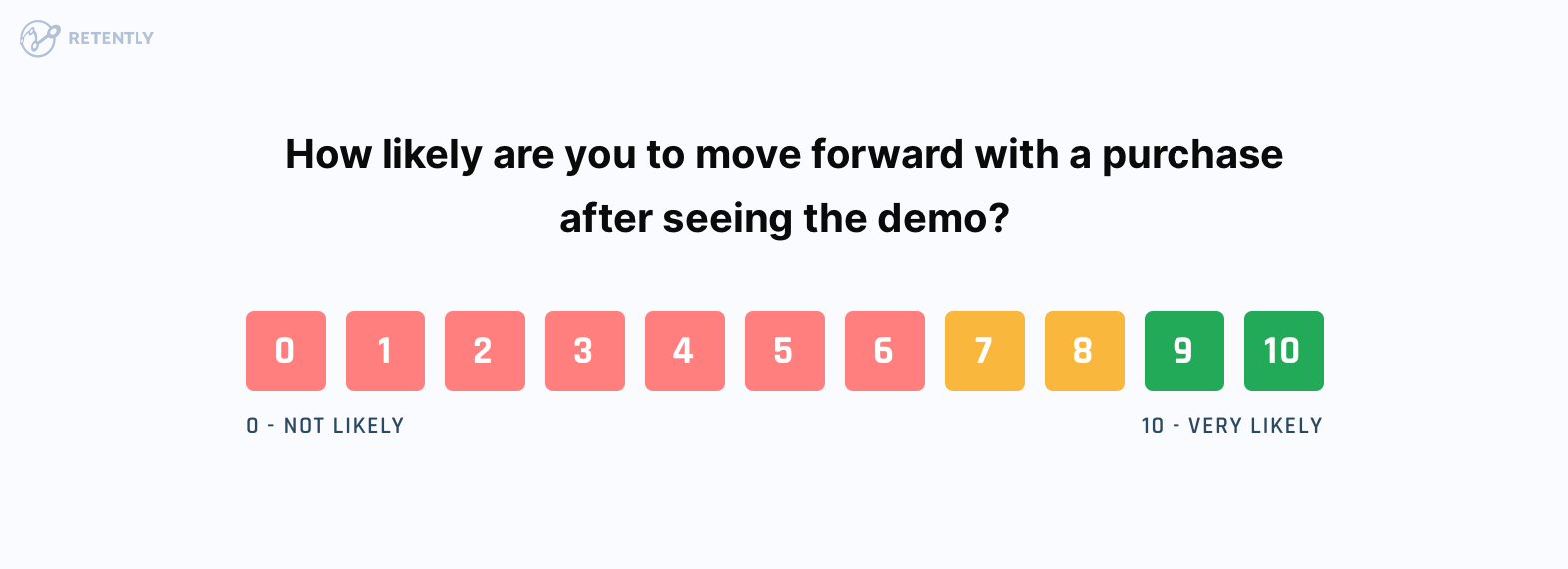
NPS surveys can assess how effective the demo call was in convincing the prospect to transition to the next stage. CSAT is also a suitable option for the case. Companies can identify improvement areas by asking customers to rate their satisfaction with different aspects of the demo call, such as the product demonstration and the follow-up process. For example, if the CSAT survey shows that customers are unsatisfied with the demo, the company may need to provide better training for their sales team.
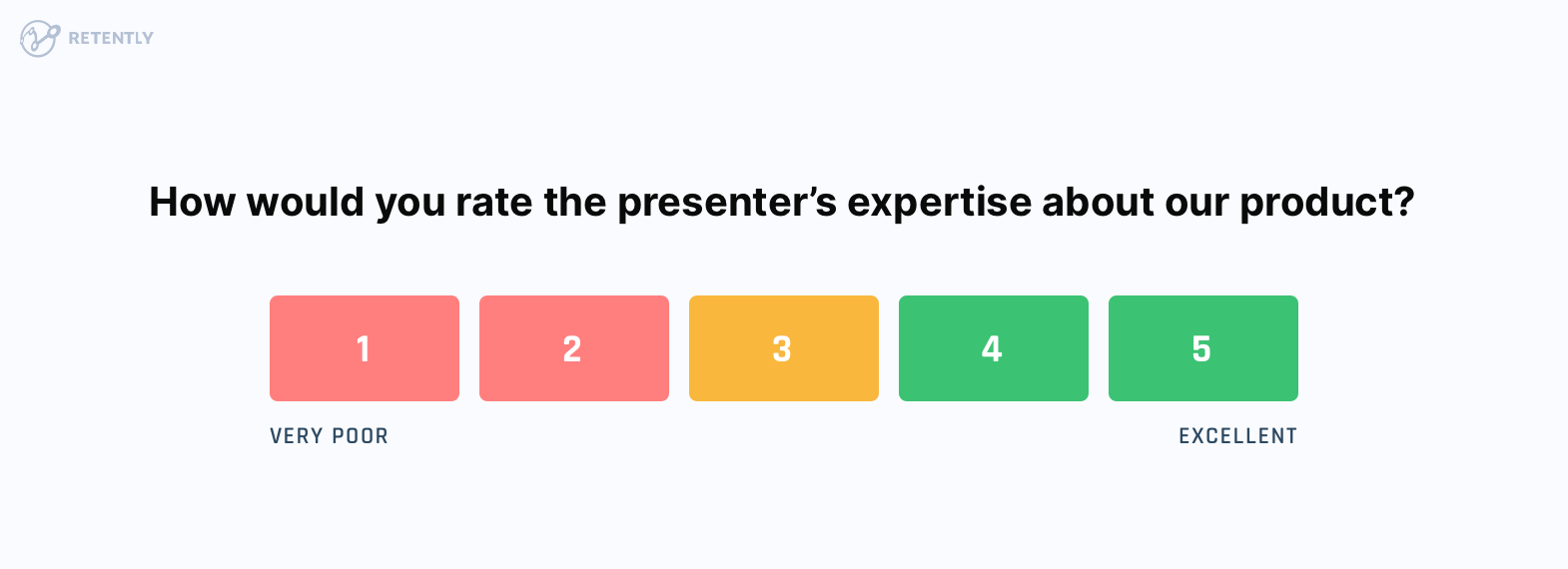
Companies should consider sending the survey within a few hours to a day after the call to get the most accurate and relevant feedback.
Let’s explore some survey question examples for the case.
- How likely are you to move forward with a purchase after seeing the demo?
- How would you rate the presenter’s expertise about our product?
Bonus questions you can add to the post-demo survey:
- Did the demo cover everything you wanted to know about our product?
- Was the demo delivered in a clear way?
- Did the demo help you understand how our product can benefit your business?
- Was the demo personalized to your needs and interests?
- Did the demo address any concerns or questions you had about our product?
- Was the demo easy to schedule and attend?
2. Free Trial or POC Stage
Potential customers now get a chance to test the product before committing to a purchase. Only a positive and seamless experience at this point in the SaaS customer journey can increase the chances of conversion.
Post-trial survey
Providing free trials to customers is a common practice among SaaS companies. Yet, you can’t send a customer survey immediately or a few days after the trial starts expecting your potential customers to have a solid grasp of your service. However, toward the end of the trial, users are meant to decide whether your service meets their requirements while comparing it to competing alternatives.
As the name implies, post-trial surveys are shared via email or in-app with users who have completed a free trial and can provide informed opinions. The feedback is essential for measuring the trial’s effectiveness in converting them into paying customers and streamlining processes. Irrespective of whether they churn or keep using your service, running satisfaction surveys will help you better understand your target audience. In any case, first, make sure the customer has actually used the service before making any assessments or decisions.
The most appropriate surveys for this stage are CSAT and CES surveys. CSAT will help evaluate the user experience during the free trial and identify whether the product meets their expectations and fits their needs.
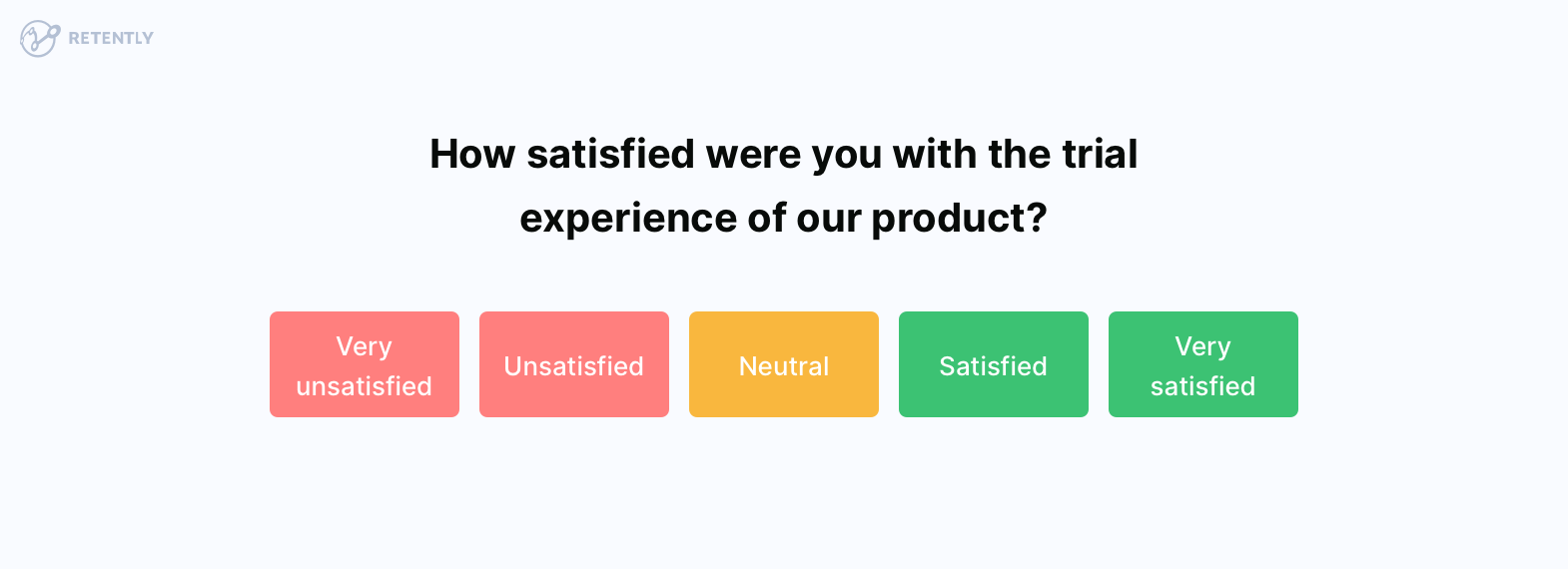
Sending automated CES surveys after a customer starts using your product helps measure the efforts undertaken by the said customer to engage with it and identify in real-time any pain points clients may encounter. It is the best way to find out whether a customer had difficulties setting up and starting to use the product.
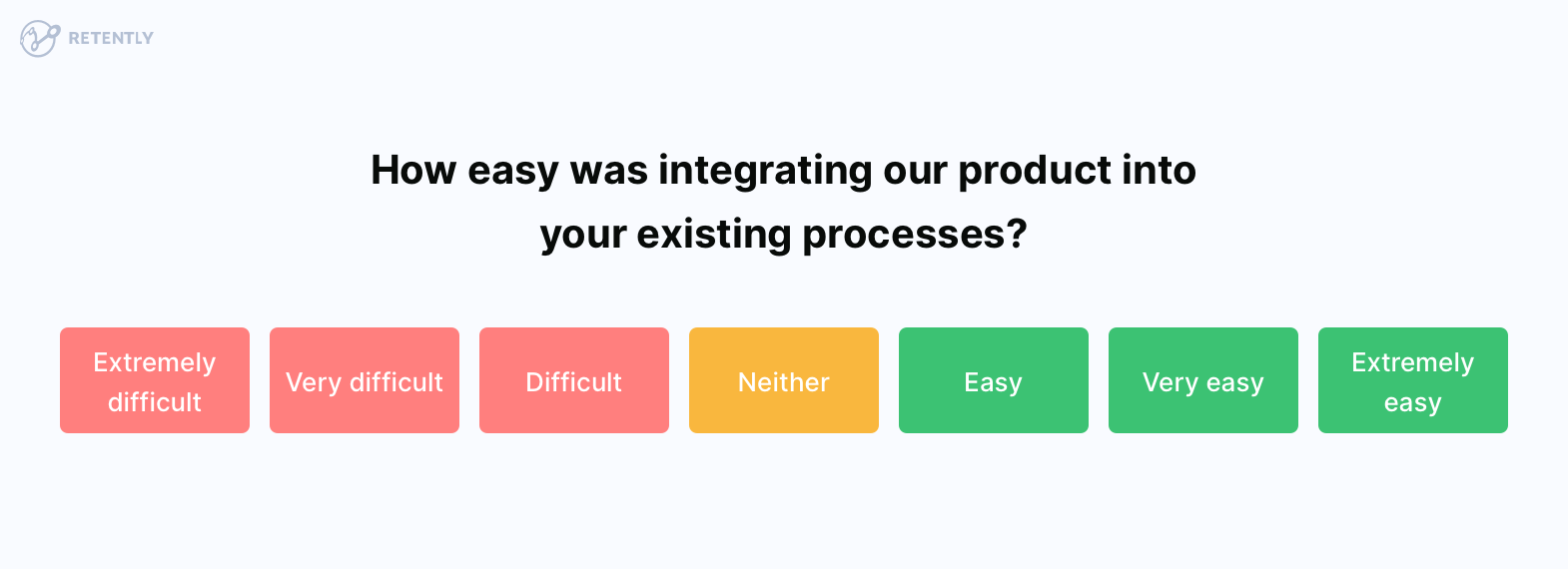
Both survey types will give you a clear picture of how the user perceives your product and will show how satisfied they are so far. In addition, by analyzing the collected data, you will be able to predict behavior in terms of churn, identify relevant subscription plans, and take timely measures to boost customer retention.
Immediately after the trial ends, send an NPS survey to those who did not convert into paying customers to determine the rationale behind this decision. The reasons will differ, like available lower-priced options from the competition, the platform being unsuitable for their needs, or the lack of specific features. Here you should develop relevant solutions and close the loop with trial customers.
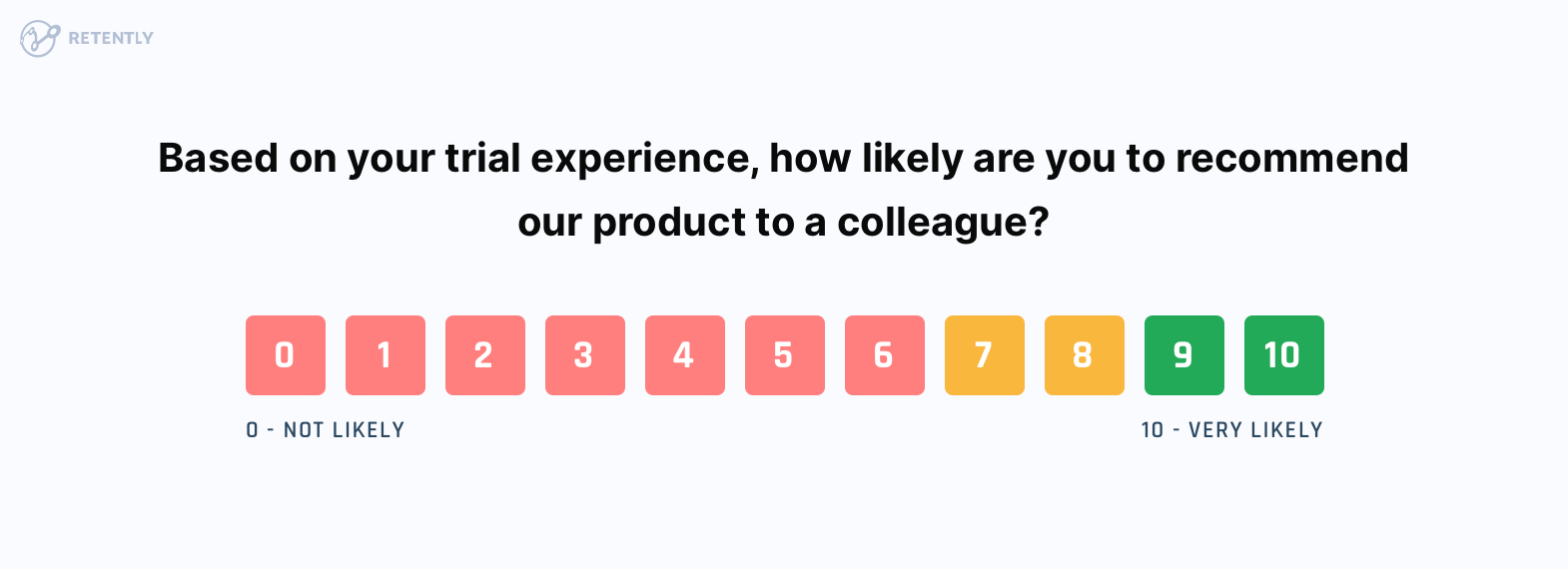
At the same time, it might be wrong to treat these prospects as lost customers because, very often, the reason is quite simple – they did not have enough time to actually explore the software. In this case, offering an extension of the trial might do the trick.
We’ve got you covered with some survey question examples you can use at this stage:
- How easy was it to sign up for a free trial?
- How easy was integrating our product into your existing systems and processes?
- How satisfied were you with the trial experience of our product?
- Based on your trial experience, how likely are you to recommend our product to a colleague?
Bonus questions:
- Did the trial give you a clear understanding of our product’s features and capabilities?
- Was the trial period long enough for you to fully evaluate our product?
- Did you encounter any issues or technical difficulties during the trial?
- What suggestions do you have for improving our product based on your trial experience? (open-ended question)
- What product features would have made it more useful for your business needs? (open-ended question)
Moving forward, surveys are also a great way to measure proof of concept success by capturing insights from potential customers. Designed to gauge interest in a new product or service, this type of survey asks potential customers about their attitude towards the concept, including whether they would be likely to use it, how it compares to existing solutions in the market, and what features or benefits they find most compelling.
You can use NPS surveys to determine whether your product is meeting the needs of your target market. NPS surveys will look into customer likelihood to recommend it to others with various follow-up questions that can elicit the benefits one could get, improvement ideas, and overall appeal.
Measuring proof of concept with surveys can provide valuable insights that can increase a product’s chances of success in the market. The timing of the survey campaign will depend on the specific goals and stage in product development.
3. Onboarding and Implementation Stage
It’s the stage where customers have the tools and resources they need to succeed. At this touchpoint in the customer journey, SaaS businesses have the opportunity to not only prove the value of their offer but also build a strong customer relationship.
Onboarding survey
The survey your customer success team should keep an eye on is related to onboarding and is triggered after your trials convert into paying customers.
The onboarding phase is critical for customer retention, with a poor experience being one of the leading reasons for customer churn. Onboarding sets the tone for the entire customer experience and ensures that customers are successful with the product. A seamless process will help customers understand the value of your product or service and make the most of its functionality, hence driving user engagement and increasing adoption rates. A poor onboarding experience, on the other hand, will inevitably lead to frustration and, ultimately, customer churn.
Simply put, onboarding defines whether a customer would keep using your service or shop for an alternative. That’s why its impact shouldn’t be waived, and it’s crucial to make it as effortless and intuitive as possible to set the ground for a fruitful relationship with your customers.
NPS surveys are suitable for assessing overall customer satisfaction during the onboarding phase. When it comes to newly converted customers, give them a month to properly onboard your product and make an informed opinion about it. Then, follow up with an NPS survey to determine their likelihood to recommend score and identify any pain points that need immediate attention.
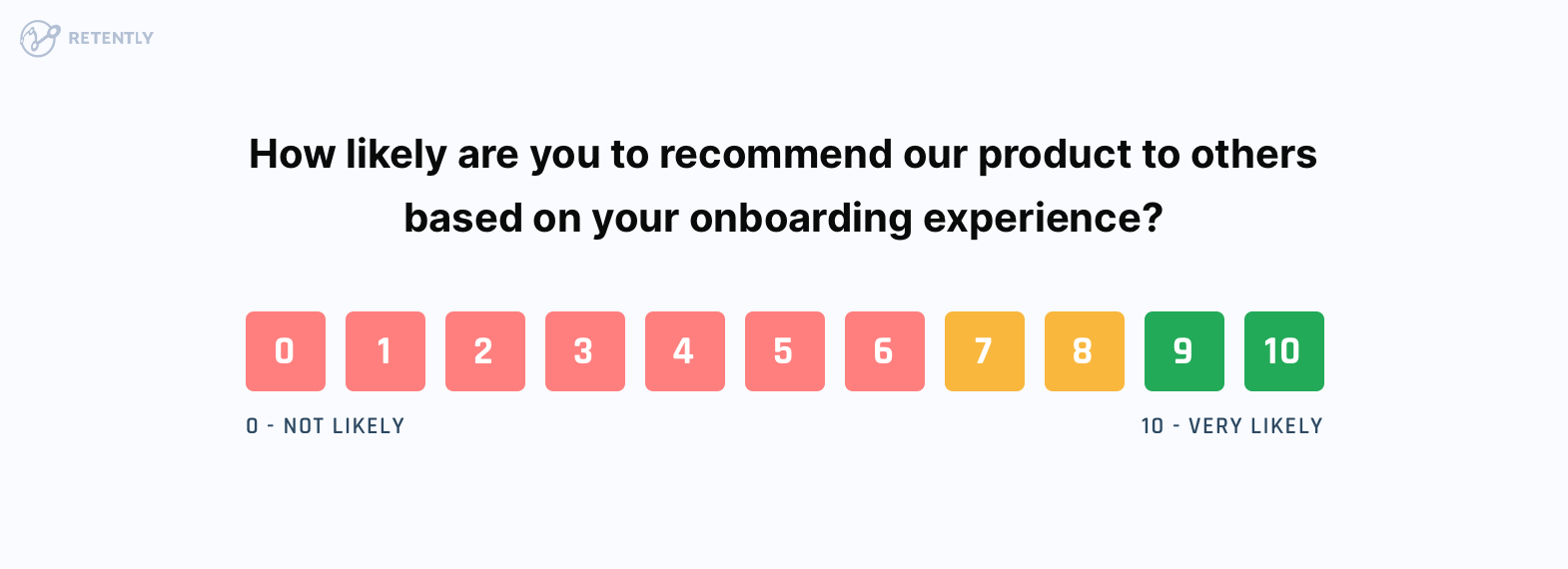
By asking customers whether they would recommend the product to others, SaaS companies can identify if customers are satisfied with the product and are likely to continue using it. CSAT surveys can also be used to assess the onboarding experience. By inquiring about customer satisfaction with the onboarding process, companies can surface improvement opportunities. The feedback should be used to immediately address any issues, continuously improve the onboarding process, and hence drive the overall success of your business.
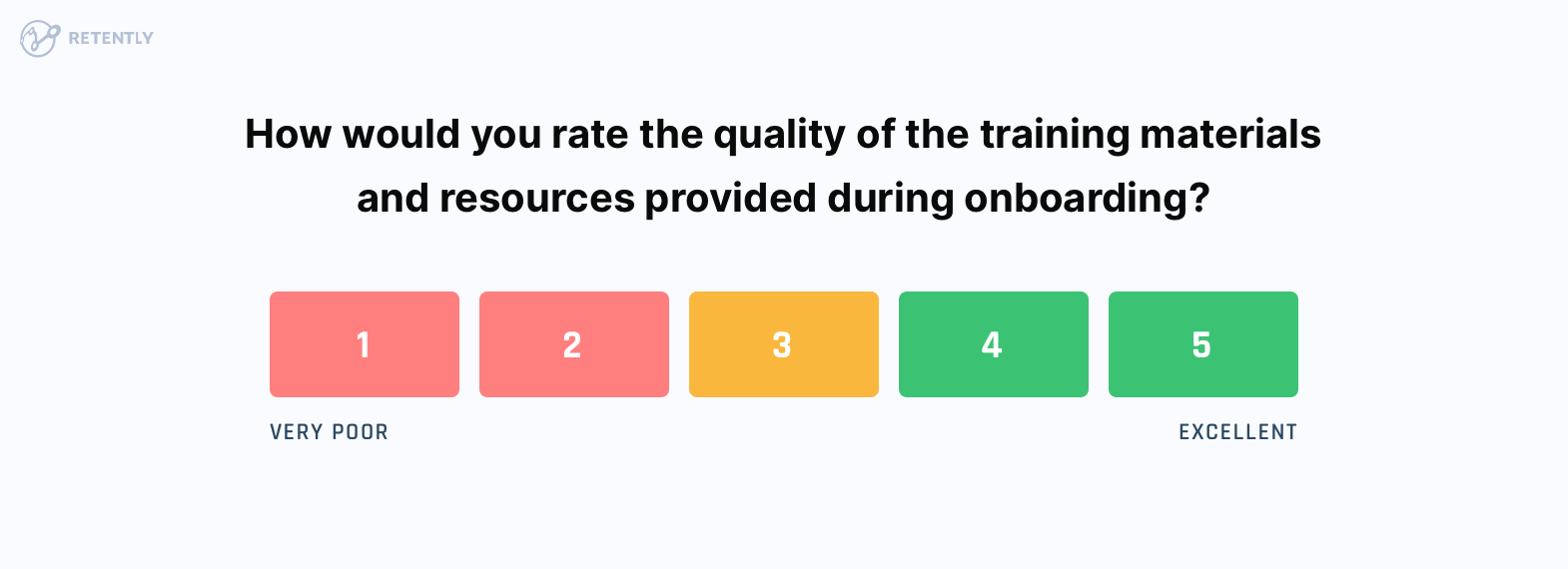
To address the onboarding concerns, providing a genuine and informative response can prove beneficial. Whenever relevant, redirect users toward your help center or arrange a set-up call in order to guide them in their learning process.
Let’s move on with some question examples to use for the SaaS onboarding survey:
- How likely are you to recommend our product to others based on your onboarding experience?
- How would you rate the quality of the training materials and resources provided during onboarding?
Bonus questions:
- How would you rate the level of personalization/customization offered during onboarding?
- How would you rate the level of engagement/communication with our team during the onboarding process?
- How satisfied were you with the quality of the onboarding support provided?
- Was the onboarding process for our product clear and easy to understand?
- Did you encounter any technical issues or challenges during the onboarding process?
- Did the onboarding process provide a clear understanding of the value proposition of our product?
- How easy was it to access and use the customer support resources provided during onboarding?
- How could we improve our onboarding process to better serve your needs and preferences? (open-ended question)
4. Ongoing Use and Support
This is when customers actively use the product and may require ongoing support from the company. SaaS companies must keep track of customer sentiment throughout this stage to confirm clients are happy with the product and the support they receive.
Helpdesk is an inherent part of any SaaS company. This team is the first point of contact when customers have any issues or questions. Naturally, measuring the effectiveness of support interactions and customer satisfaction with the team is likewise important. So now it’s time to look into transactional campaigns.
Transactional post-service interaction survey
Your customer support is the go-to resource for customers when they face an issue. Users don’t want long waiting times and expect their concerns to be solved quickly. In many cases, there is no one else they can talk to, so they judge the reliability of your SaaS business and make decisions to leave or stay with your company based on their interactions with customer service. That’s why gathering customer feedback on these interactions holds significance.
The rule of thumb for any SaaS company is to send transactional CSAT surveys after each interaction with the support team or after a ticket is closed in order to measure customer satisfaction with the specific agent and the provided assistance. We recommend a throttle of a minimum a month to avoid survey fatigue. Since transactional campaigns relate to specific events, they provide a better understanding of the reasons for any shifts in customer sentiment. This allows businesses to identify issues immediately, swiftly fix them, and take preventive action to reduce the likelihood of recurrence.
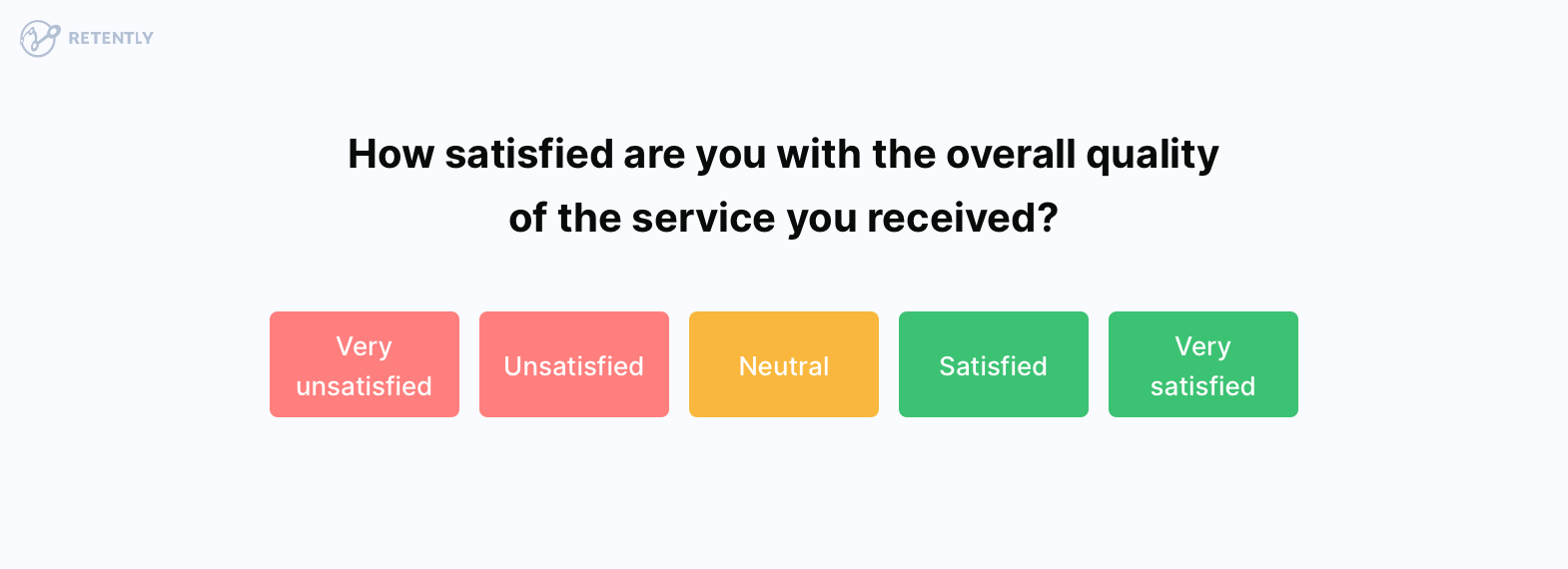
Naturally, not all interactions happen online. Depending on the nature of your SaaS business, customers can personally come to your office. It doesn’t mean that you can’t measure this interaction as well. Since it will refer to existing or potential customers, you will have their contact information. Sending a quick CSAT survey will not take much time but will provide tons of useful feedback.
CES is also suitable for this phase. By asking customers about the effort required to resolve an issue with the help of the support team, companies can identify how the support process can be streamlined and in what areas the support service excels or needs training.
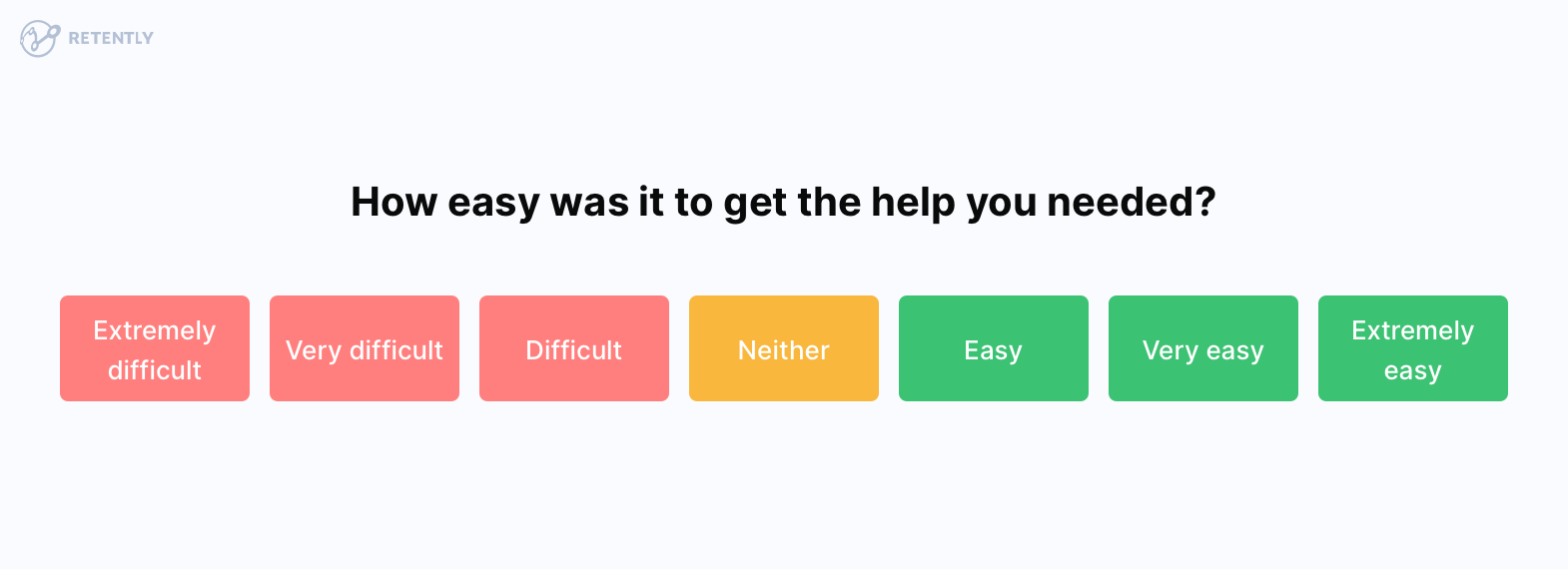
Here are some question examples to consider:
- How satisfied are you with the overall quality of the service you received?
- How easy was it to get the help you needed?
Bonus questions:
- How satisfied are you with the way the support team handled your request?
- Did we meet your expectations during your recent service experience?
- Is there anything we could have done better to improve your service experience?
- Did you experience any difficulties navigating our service channels or resources?
- Were the provided instructions clear and easy to follow?
- Is there anything we could have done to make the service experience easier or more efficient for you?
- How easy was it to find the solution you needed?
- How satisfied are you with the speed/efficiency of our service?
- How satisfied are you with the professionalism of our support representative during your recent interaction?
Major product update campaign
Happy customers translate into a thriving business with steady revenue, but in order to keep customers satisfied, SaaS companies have to meet or exceed expectations through their products. By understanding the needs of their customers via surveys, SaaS businesses can develop products that cater more effectively to their customers and set themselves apart from competitors.
Updates and new features are crucial to ensure your product remains relevant and can keep up with the evolving market, especially in the highly competitive SaaS vertical.
With new technologies emerging and developing every day, SaaS businesses need to be innovative and continuously generate fresh solutions to stay competitive. However, as happy and excited as you can be about the updates and improvements, your customers have the final say. It is them who will define whether you did the right thing.
Keeping track of customer satisfaction throughout the customer journey is essential for any SaaS company. Sending surveys after major product updates will help identify any shifts in customer sentiment.
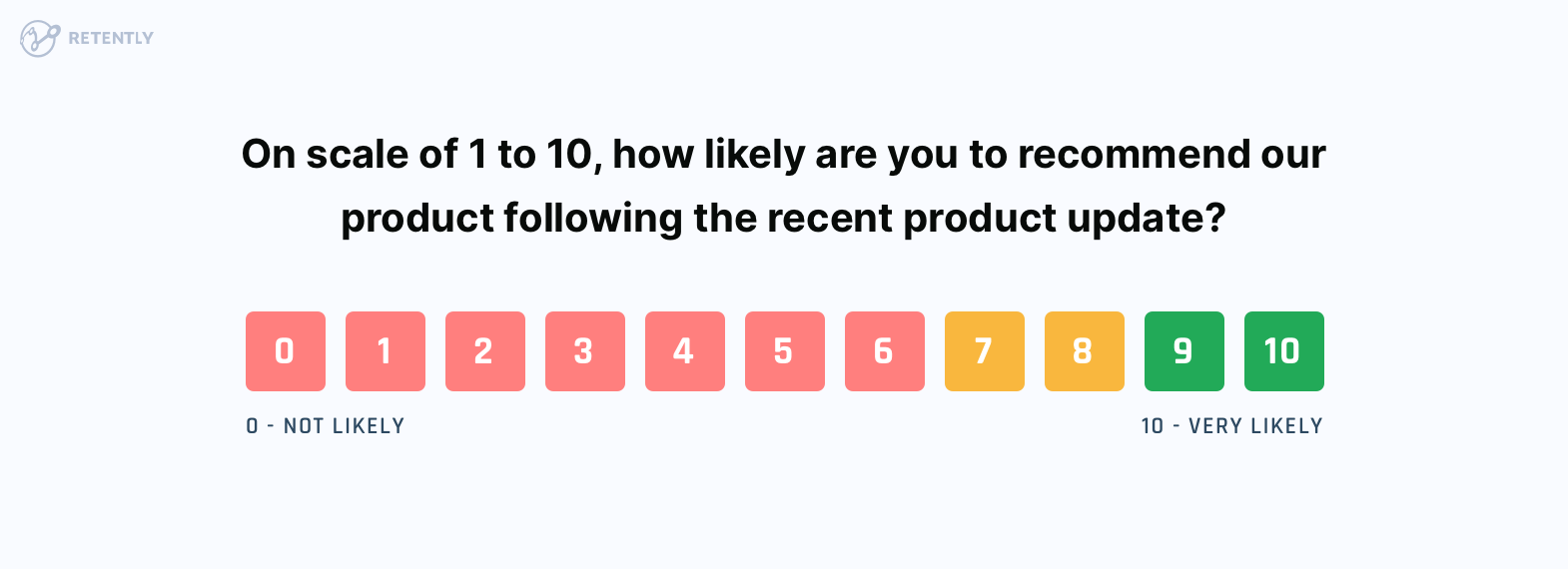
Send NPS or CSAT to identify the attitude of customers towards the update and ask for their opinion on its usefulness and overall impact on their performance. Even if everything went well during the testing stage, once released, the situation might be different. So your customers will have an opportunity to share information on bugs and glitches they encountered. In addition, encourage them to share ideas and suggestions on improving the product. As your customers know their needs better, you may get useful feedback, though it doesn’t mean you should start implementing them immediately. Analyzing the market and looking into demand comes first, as in practice, the requested features may not be essential for the target audience. Anyway, thanking customers for their ideas is a nice touch, showing that you care about their opinions and needs.
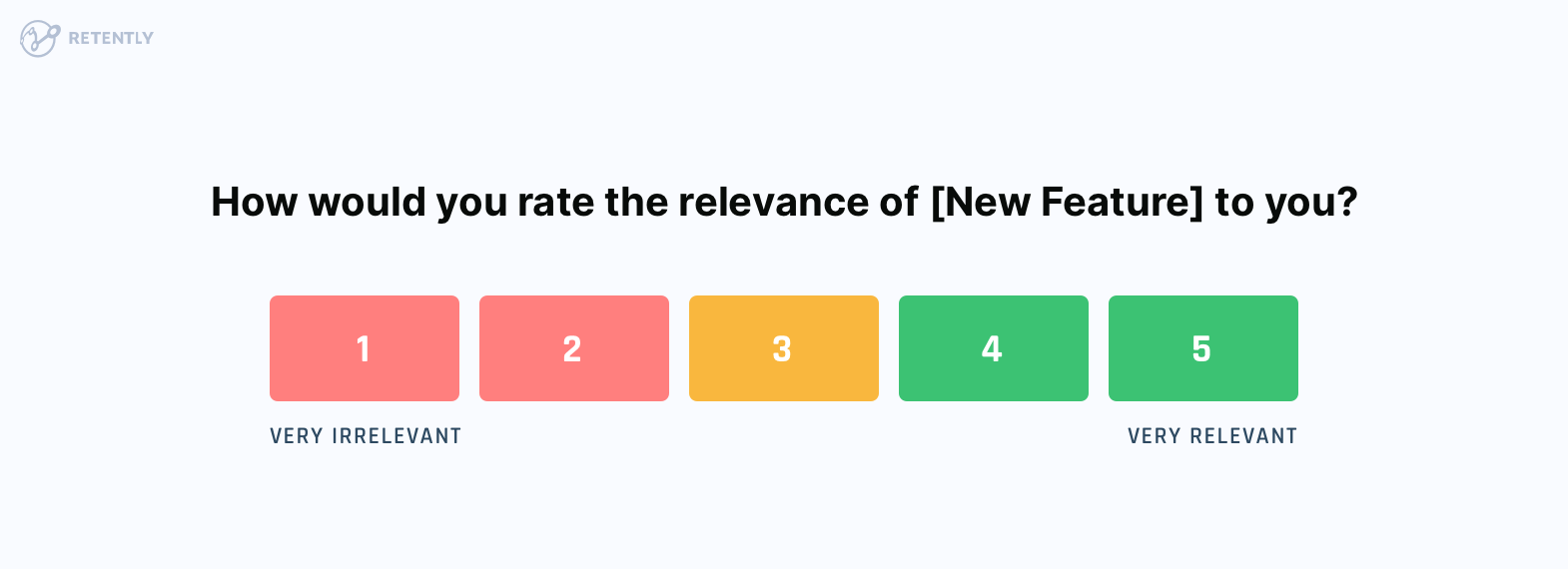
Segmenting suggestions into feedback themes will come useful, as this way, it will be easier to share across the team. In addition, you can use positive feedback to boost employee morale, motivation, and creativity.
It’s important to note that not every customer should receive this survey. While it is better to get insights from everyone, by this time, customers may be overwhelmed with surveys, so selecting a customer sample, for example, those who haven’t received any surveys in the past 6 months, is a way to go.
You can get inspired by exploring some of the survey question ideas below:
- How would you rate the relevance of [New Feature] to you?
- How satisfied are you with the level of communication/information provided about the product update?
- On scale of 1 to 10, how likely are you to recommend our product following the recent product update?
More ideas to consider:
- Did the product update address any issues or concerns you had with our product?
- Were the new features or changes added in the product update useful for your business needs?
- Did you encounter any technical issues or difficulties after the product update?
- Was the product update able to improve your workflow or productivity?
- Did the product update align with your expectations and needs as a customer?
- How could we improve future product updates to better serve your needs and preferences? (open-ended question)
Recurring customer satisfaction survey
You will want to keep a pulse on customer satisfaction even after the onboarding stage. If the trial and onboarding went smoothly and the customer converted, it doesn’t mean the deal is sealed, and you should stop measuring their experience.
The best way to keep track of customer sentiment is by setting up automated recurring campaigns and running them regularly, like every six months. By definition, NPS will serve the purpose best, helping you identify arising issues in time and allowing you to take appropriate measures to prevent churn and negative word-of-mouth.
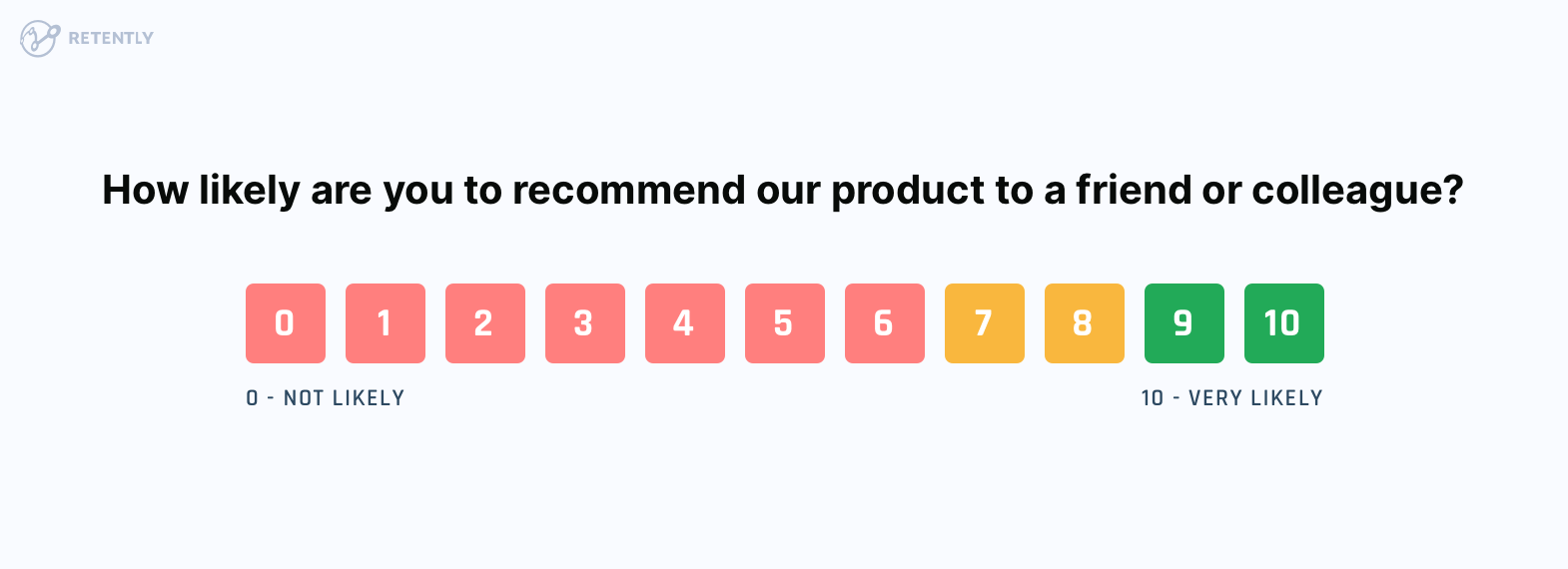
In addition, these surveys will offer insights into product demand. It doesn’t matter how often you update it: if your customers were happy with it a month ago, their priorities may easily change, or your competitors may have a more attractive offer. That will allow you to develop actionable strategies and focus your efforts on impactful changes.
The main advantage of recurring campaigns is that they are sent to a relevant audience – customers who have used your product regularly and can provide dependable feedback. Tracking their sentiment over time will enable you to predict behavior and always be one step ahead.
Still, as you will send these surveys regularly, ensure they are time-efficient and don’t run them too often: customers can get easily frustrated and will stop responding if you flood them with endless questionnaires. To increase the response rate, send reminders to those who haven’t opened or completed the survey.
Here you should also consider the most suitable survey channels to employ. Depending on how and when customers use your product, email or in-app surveys will yield better results. While in-app surveys may be perceived as intrusive, their contextual relevance (popping at the right moment) can often lead to higher response rates. On the other hand, emails may be overlooked or marked as spam, but when crafted thoughtfully, they can generate valuable insights from customers. Choosing the right feedback channel can make all the difference in gathering meaningful and actionable feedback.
5. Renewals and Upgrades
At this point, customers have used the product for some time and are deciding whether to renew their subscription or upgrade to a higher tier. Monitoring customer satisfaction during this stage in the customer journey is essential for SaaS companies in order to ensure that customers are pleased with the product and the overall experience with the company.
Long-term subscription expiry survey
Given the competitive landscape of the SaaS industry, companies go to great lengths to carefully craft their product and pricing strategies. Many of them offer both monthly and annual payment options, yet strive for as many long-term subscriptions as possible. The benefits are clear: the income flow is consistent, and the churn rate is lower. However, if a customer signs up for an annual subscription, it doesn’t necessarily mean they will renew. Priorities change, and competitors develop new products or update existing ones, so preventing customer churn is a non-negotiable premise. In many cases, you can predict the churn by analyzing the results of recurring campaigns, but at times even they may not provide a clear picture of the actual situation.
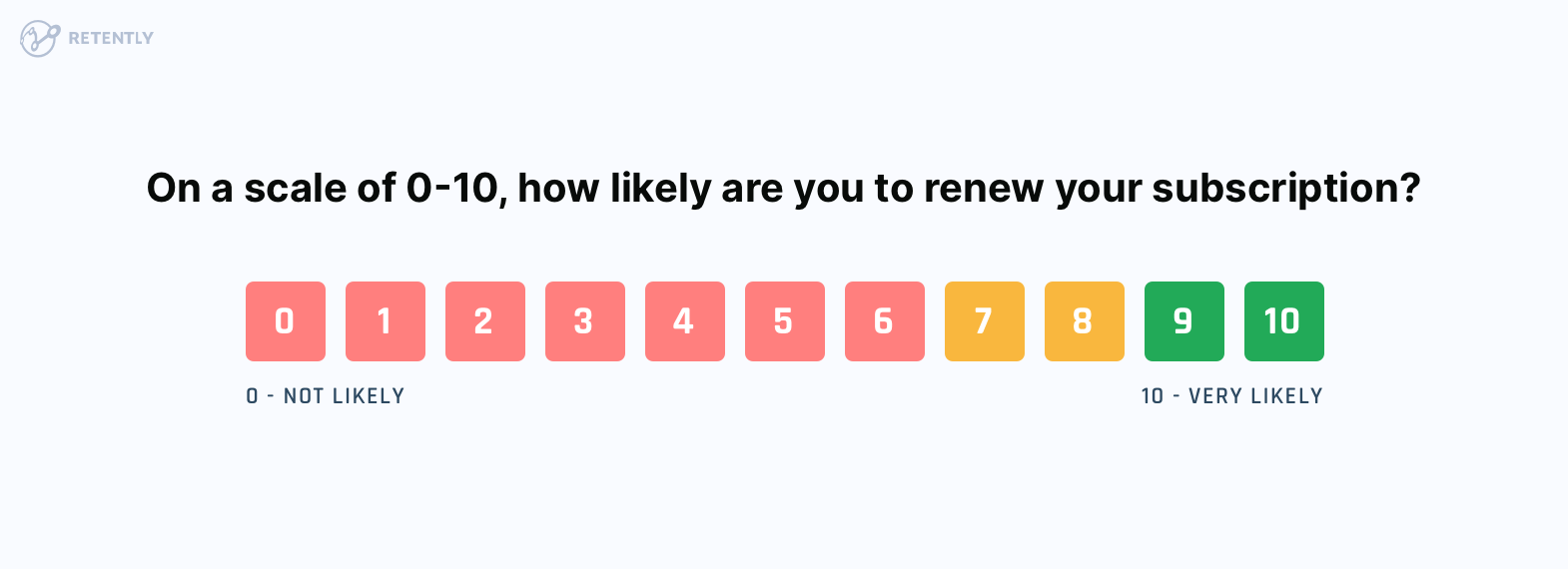
About a month before the subscription renewal is the right time to trigger subscription expiry campaigns. NPS and CSAT surveys will help you get the inside scoop on how customers really feel about your service and get actionable insights to boost retention. Open-ended questions and comments will allow customers to spell out their concerns and come up with suggestions. In many cases, issues can be solved in a short time, and your proactive approach to building lasting relationships will pay off.
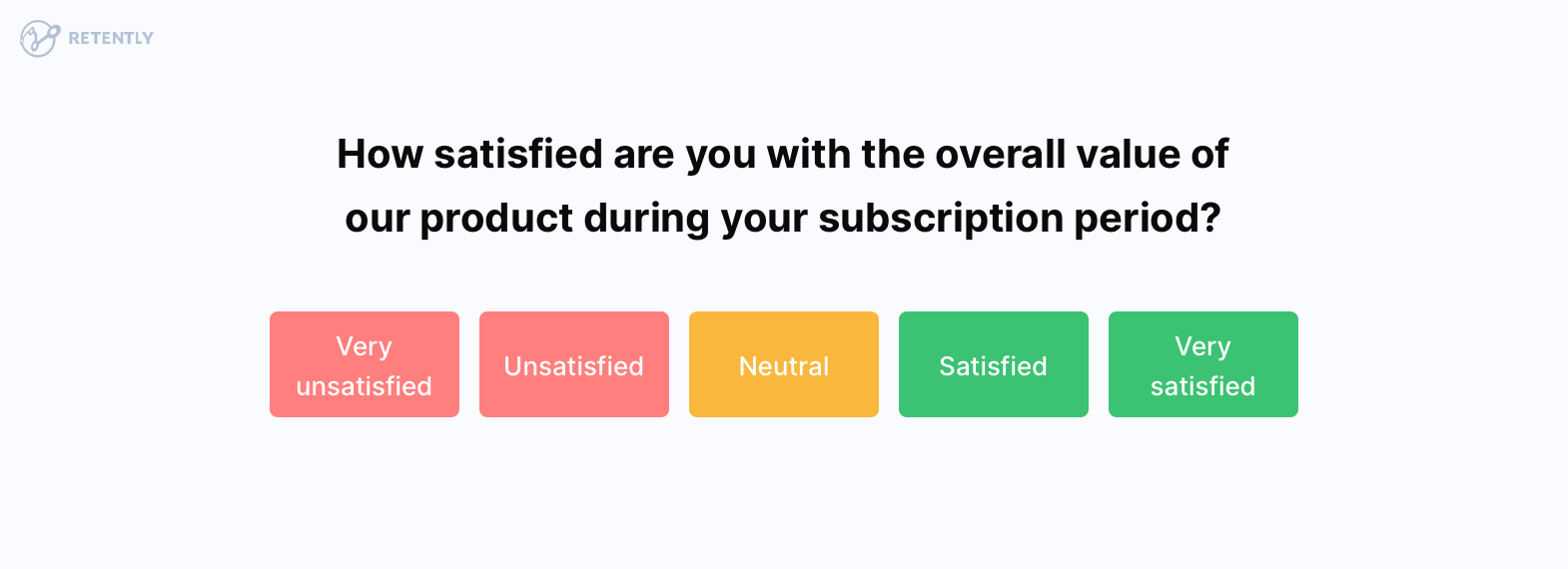
If they complain about occasional bugs and glitches, react immediately with a quick solution; if pricing is the concern, offer discounts or relevant incentives. Show them you value their trust and are open to suggestions and discussions.
Question examples relevant for a SaaS long-term subscription expiry survey campaign:
- On a scale of 0-10, how likely are you to renew your subscription?
- 0-6 score: What can we do to improve your experience? (open-ended question)
- 7-8 score: What are the areas where we can improve to earn a higher score (open-ended question)
- 9-10 score: What are some of the things we did well? (open-ended question)
- How satisfied are you with the overall value of our product during your subscription period?
- On a scale of 1-5, how satisfied are you with the service you received during your subscription period?
- Did our company meet your expectations during your subscription period?
- Was there anything specific that you enjoyed or appreciated about our company’s product/ service during your subscription period?
- Were there any areas where we fell short of your expectations during your subscription period?
Exit survey
When a customer cancels the subscription, it’s not the end of the world, though, for startup SaaS companies, each instance is impactful. Clients have their own reasons for ending subscriptions, and your task, in this case, is to find out why they did it. Instead of relying on guesswork, go back to the source – ask your customers.
Of course, having a direct conversation with a client over the phone is ideal as a sales manager can convince them to reconsider their decision. However, this approach is not always feasible, and not everyone is comfortable sharing their opinions openly. Here NPS and CSAT come to aid as ideal exit surveys.
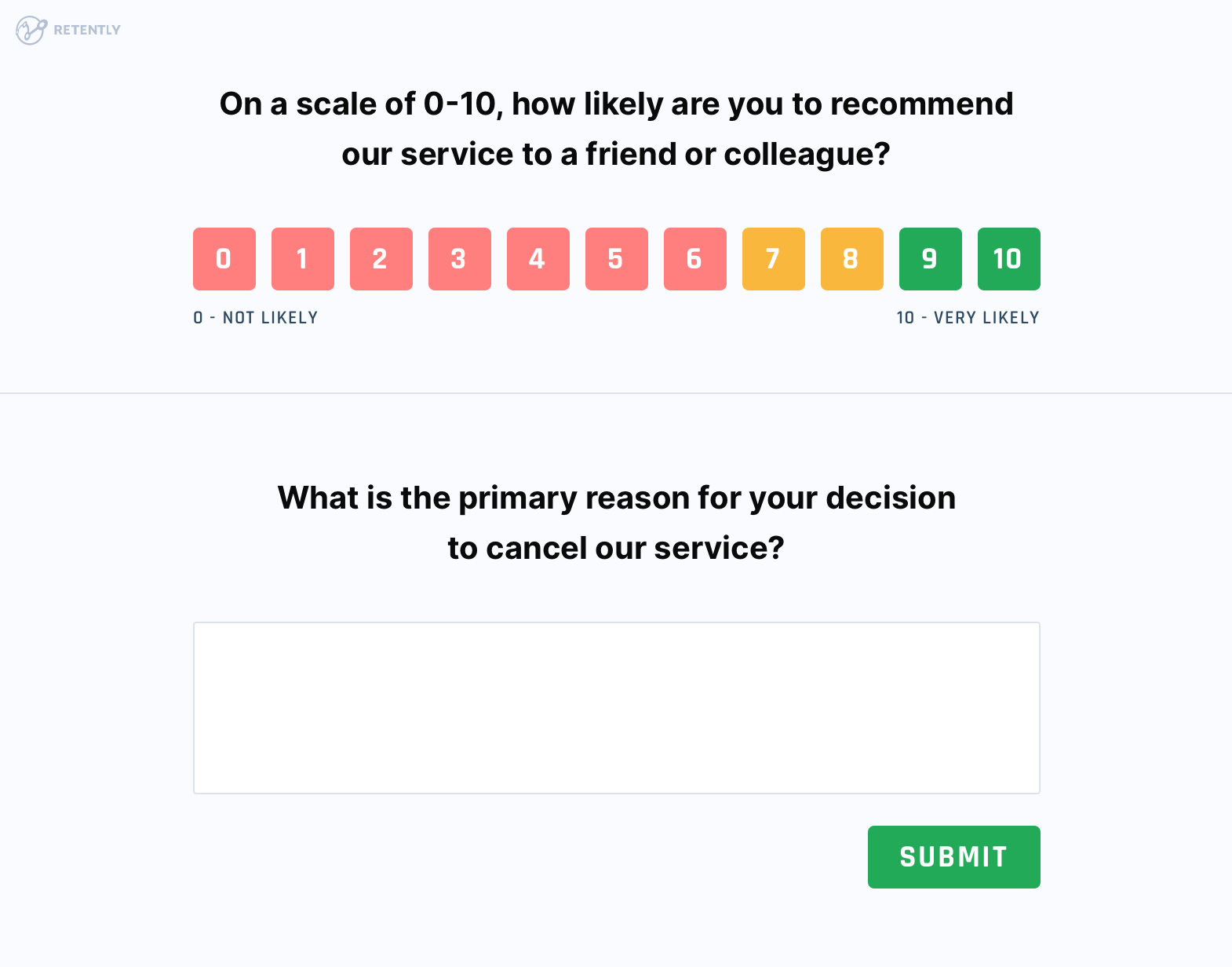
Instead of opting for lengthy questionnaires, NPS and CSAT are short: even when customers love your product, they are not willing to spend much time filling in surveys, and they will be even less inclined to do it when they cancel. NPS and CSAT consist of a couple of questions only and don’t have predetermined answers allowing customers to freely express their concerns. In addition, open-ended questions allow customers to provide a comprehensive account of their experience with your product and their reasons for cancellation.
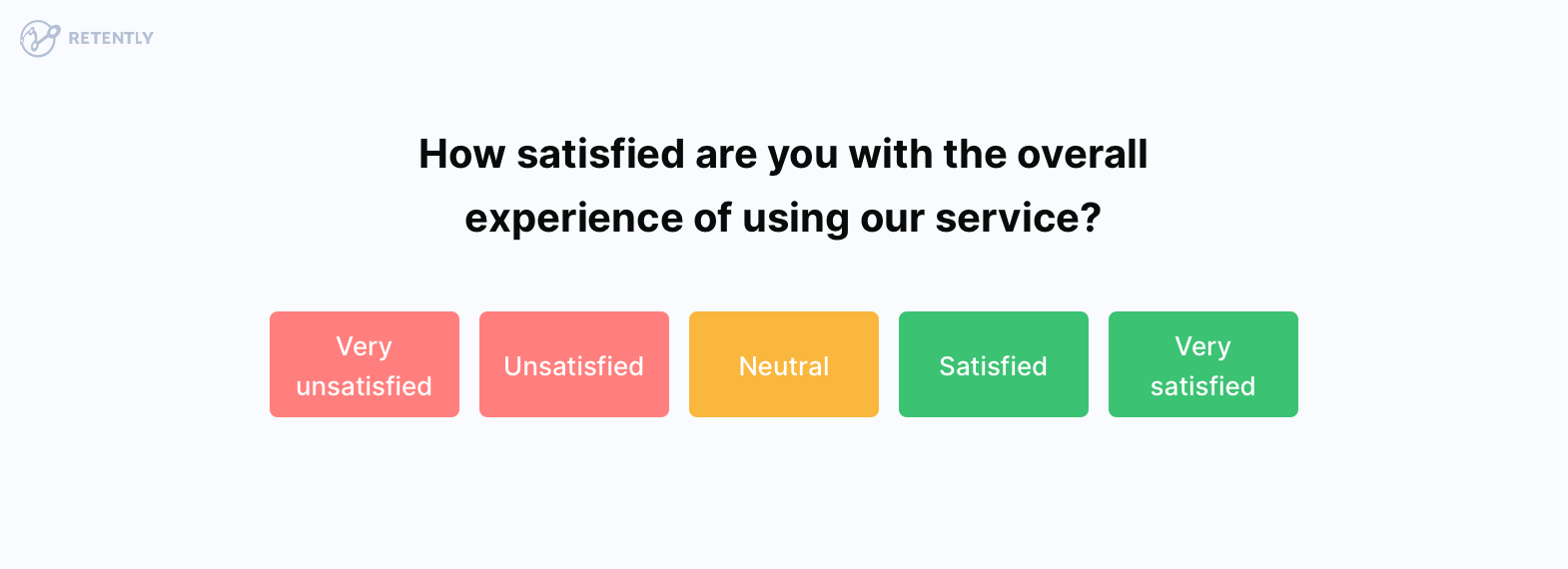
Instead of viewing cancellations as something completely negative, make them work for you. Use the survey feedback to understand the leading causes of customer churn and segment them into different groups for efficient processing. This segmentation will help you understand your weaknesses and allow you to focus efforts on relevant areas.
In addition, if you take time to respond to their concerns, you will make customers feel valued, and they will be less inclined to spread negative opinions about your product. Though it doesn’t mean they will reconsider their decision, it is a good way to show that you care, that you are a reliable partner, and maybe, in the future, these departing customers will return.
And here are some survey question examples for some inspiration:
- On a scale of 0-10, how likely are you to recommend our service to a friend or colleague?
- What is the primary reason for your decision to cancel our service? (open-ended question)
- How satisfied are you with the overall experience of using our service?
Bonus questions:
- Were there any specific issues or concerns that led to your decision to cancel our service?
- Is there anything we could have done differently to encourage you to continue using our service?
- What led to your decision to stop using our product?
- Were your expectations met as a customer?
- Were there any missing features that would have made our product more beneficial for your business needs?
- Did you experience any technical issues or difficulties while using our product?
- What suggestions do you have for improving our product or customer experience?
- Would you consider using our product/service again in the future?
And if among all the above examples you still haven’t found the ones, you can always create survey questions that are tailored to your needs with just a click using Retently’s online survey generator.
Survey customers with Retently to improve user experience
Surveys are highly beneficial for SaaS businesses that heavily rely on customer satisfaction and loyalty, given the inherently low switching barriers. With CX surveys, SaaS businesses can gain valuable insights into customer behavior and preferences, identify areas for improvement, and take proactive steps to elevate the user experience.
NPS, CSAT, and CES surveys are short and effective, and clients don’t need to spend much time responding while still providing detailed and actionable feedback. By focusing on what matters most to users throughout their customer journey, SaaS businesses can increase customer loyalty and retention and, ultimately, drive revenue growth.
Check out Retently in a free 7-day trial for a variety of customer satisfaction surveys in order to make an informed decision on whether they meet your requirements. Customize the templates to reflect your branding, connect Retently with your tools to leverage automation, and start gathering invaluable customer feedback. Use Retently to develop products that better serve your customers and differentiate you from the competition.























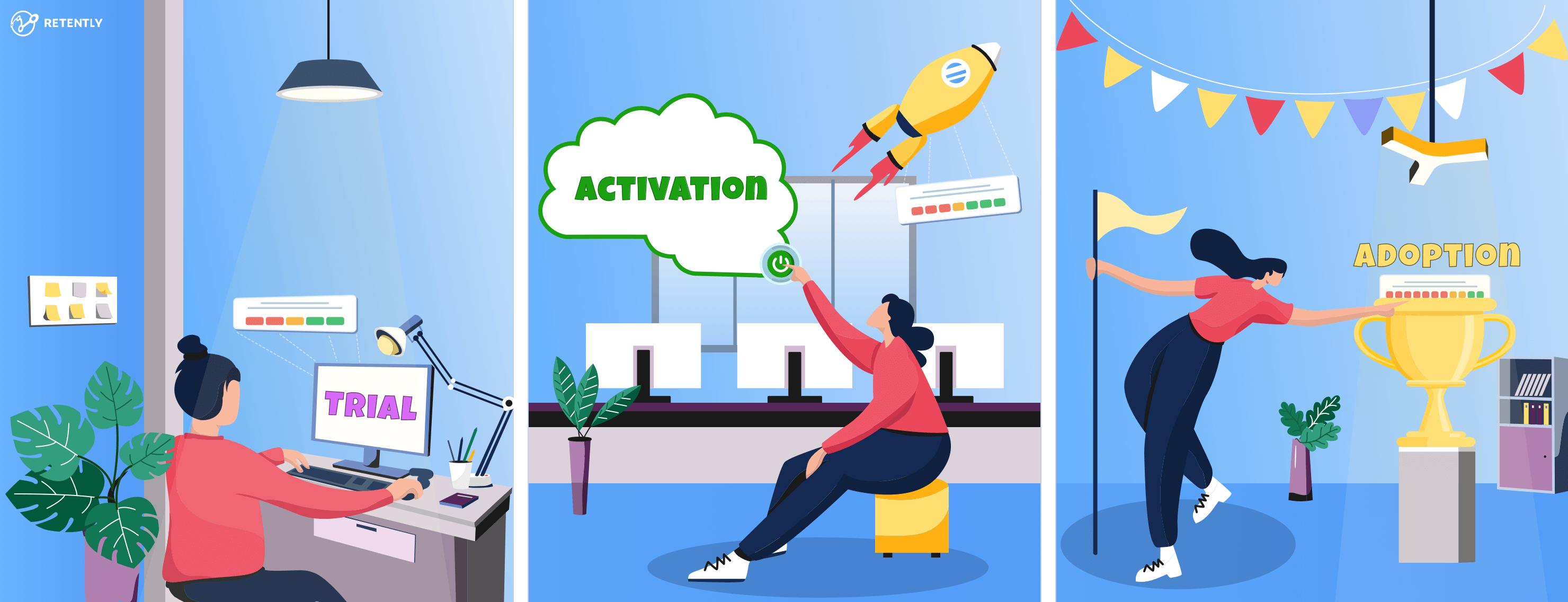




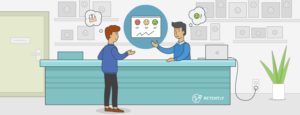
 Greg Raileanu
Greg Raileanu 

 Alex Bitca
Alex Bitca 
